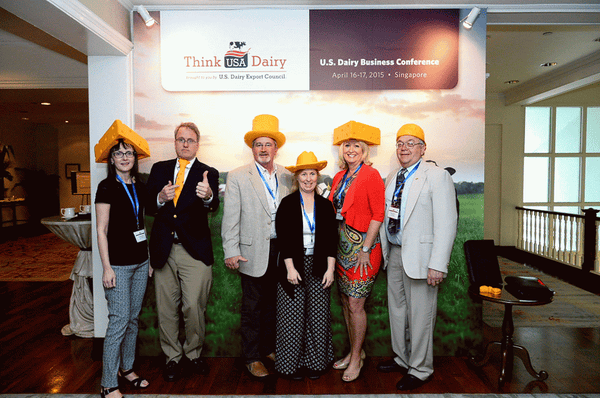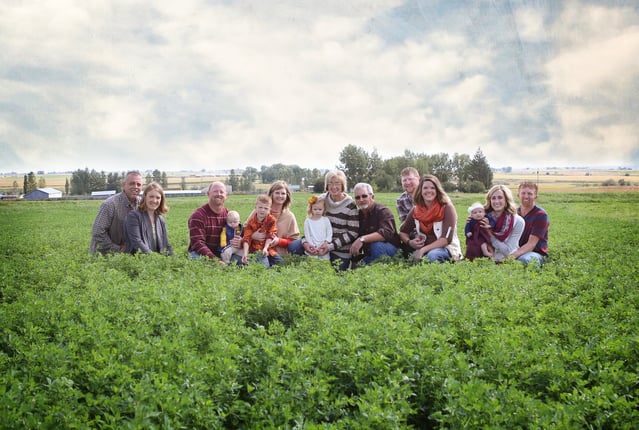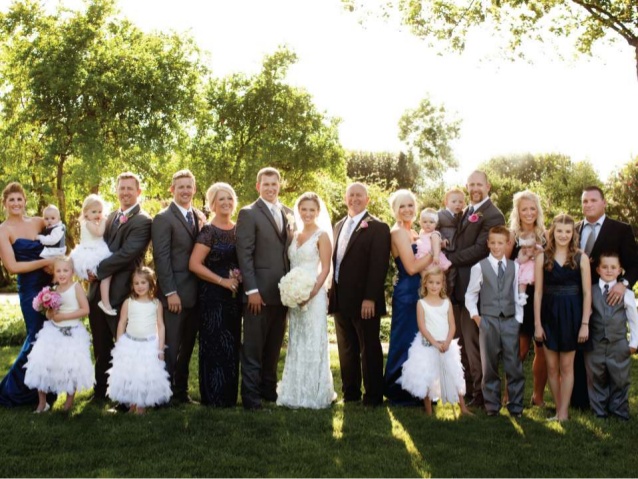-
How U.S. Dairy Farmers' Visual Storytelling 'Wowed' a Business Crowd in Singapore
By Margaret Speich May 12, 2015- Tweet
Each USDEC mission has its “aha’ moments when a light bulb goes on over our dairy farmers’ heads. A gasp from a S.E. Asia audience prompted a recent "aha."
Every two years, the U.S. Dairy Export Council takes four dairy farmers and two dairy trade journalists on an informational “mission” to a key export market. I coordinate and lead these trips and unabashedly think they are one of the most effective educational experiences we could offer our farmers, who fund us through Dairy Management Inc. and the check-off program.
I grew up on a Wisconsin dairy farm and enjoy taking hard-working farmers to other parts of the world to see how our U.S.milk is being used overseas. Each mission has its share of “aha’ moments when you can almost see a proverbial light bulb go on over our dairy farmers’ heads. My communications colleague Mark O’Keefe and I call this moment the Audible Gasp because that's what happened when Southeast Asians saw a big-screen wedding photo of a fit, tall, handsome and wholesome California dairy family.
To borrow a phrase from marketing-speak, these farmers are “influencers.” That means they have the clout and credibility to bring the U.S. dairy export story back home to fellow board members, co-ops and their personal networks via social media.
But we recently saw in Singapore how effective they can be delivering the message overseas.I previously took farmers on missions to Japan, the United Arab Emirates and China, and planned a mission to South America.This year, from April 12-22, my mission was to Southeast Asia. It’s an important market because exports there have more than tripled in five years to $1.3 billion annually, with plenty of upside.Our visit to Singapore, the financial and shipping hub of Southeast Asia, coincided with the U.S. Dairy Business Conference, where purchasing and marketing decision-makers from throughout the region would learn about the advantages of U.S. Dairy.
I knew our farmers would be responsible for a 30-minute presentation at the conference. But when I saw our noon time slot I was concerned. How would we keep the attention of hungry people whose heads were filled with several hours of charts, graphs, facts and figures?

Four U.S. dairy farmers and USDEC staff don "Cheesehead" attire to give the big "thumbs up" after a presentation at the U.S. Dairy Business Conference in Singapore. I'm on the far left.
Mark and I decided we would aim 10 inches lower, for their hearts. But how? Visual storytelling.
We did telephone interviews with our farmers to determine the story lines that best illustrated larger truths about our industry. One point we wanted to emphasize in each story: the family angle.
There is a stubborn myth spread by our critics that most U.S. dairy farms are run impersonally by large corporations when the fact is more than 99 percent of our more than 50,000 farms are family-owned and operated, many for generations.
Realizing a picture is worth 1,000 words—probably 10,000 just before lunch—we sent a splendid photorgrapher to all four farms. Our themes, and the respective farmers delivering their personal stories would be:
1. Quality: John Brubaker; Buhl, Idaho
2. Animal Care: Kima Simonson, Deer Park, Wash.
3. Environment: Harold Shaulis; Somerset, Pa.
4. Relationships: Renae De Jager; Chowchilla, Calif.We did a dry run the night before to practice our tightly choreographed multi-media presentation. Some of the farmers were a little nervous, and. To be honest, so was I.
I was taking a risk with this approach.
These were not staged photos with models brought in from the big city, but real farm families on raw, unfiltered farms. We’re talking soiled overalls from time in the field, wrinkled brows after years of milking before the crack of dawn and toiling on tractors in the sun. And yes, manure. It doesn't get much rawer than that.
Was Southeast Asia ready for the “real deal?” Were we?
We got ant indication the next day when the first family farm photo flashed before our audience on two large screens. It was this shot of John Brubaker and his extended family sitting in a green field of alfalfa, underneath an enormous Idaho sky dotted with puffy clouds.
 This shot woke up the crowd: John Brubaker and his family at his dairy farm in Buhl, Idaho,
This shot woke up the crowd: John Brubaker and his family at his dairy farm in Buhl, Idaho, I noticed the more than 100 purchasing and marketing decision makers from 10 countries perk up. Some sat straighter. Others leaned forward. Many smiled. As if someone had said, "Beam them there, Scotty," these Southeast Asians had been transported to John’s farm in Buhl where he had them drinking U.S. milk from bottles as if they were his calves.
Kima then described her 160-acre, 80-milking cow dairy farm nested among the beautiful rolling hills of eastern Washington State. She talked about her love for their animals: They’re milked by family members twice a day, someone from the family attends to every calving and some cows, Kima told the story of Olivia, have been tenderly given names.
Harold told of his commitment to the natural environment. Because his farm is located in a hilly section of southwest Pennsylvania, he has to be conscious of environmental issues and does whatever he can to prevent runoff from his dairy. He runs his 360-acre, 120-cow farm knowing he is a member of a global community and acts with the highest integrity toward others. Food safety is very important to him, and he works with other dairy farmers to supply milk to needy people through food banks.
Finally, Renae batted cleanup with words and images not only about her picturesque family farm, but the popular agri-tourism center and winery she runs near the gateway to Yosemite National Park.
The audience remained transfixed as the last image from our presentation appeared on two screens. It was a De Jager family wedding portrait taken at the winery.

The De Jager wedding shot that prompted an audible gasp from an audience in Singapore that apparently had never seen what a typical California family raised on U.S. Dairy looks like.
Gasps rang through the conference room, prompting Renae to pause for a moment, not knowing what to make of it at first. She looked up, saw the approving expressions on the faces, caught her composure, and continued.
That was the "aha" moment when we realized we not only had a hit on our hands, but a home run.
I can’t say what was in every person's mind who gasped but I’d like to think it had something to do with wonder, delight and milky-fresh wholesomeness, as if to say, “So this is what U.S. dairy products do for you!”
Several importers told us later that they had never seen photos of an authentic American dairy farm. For some, it was an emotional experience. One distributor nearly cried describing it. You can read more reactions and see the photo slideshows in this blog post.
So what’s the takeaway, the broader application for exports and our industry?
It’s this: Authentic stories about American farm families resonate across seas and cultures. Our farmers are effective ambassadors for U.S. Dairy because people, no matter where they may live, crave the real deal.
Twenty-four dairy supplier and processing companies were at the conference in Singapore, illustrating how our USDEC members develop and maintain strong working relationships in the markets they export to. But something special happens when an importer or food distributor sees where and with whom the American farm-to-table dairy story begins.
In a post-conference survey, 9 out of 10 participants said the conference met their expectations. The highest-rated presentation? You probably guessed it, the visual stories of our four U.S. dairy farmers.
Having the good fortune of growing up on an American dairy farm and being around dairy farmers all my life, I know about their hard work and commitment to excellence. It was gratifying to see their words and images connect in a powerful way with international customers.
The U.S. Dairy Export Council is primarily supported by Dairy Management Inc. through the dairy farmer checkoff that builds on collaborative industry partnerships with processors, trading companies and others to build global demand for U.S. dairy products.
10 Most Recent Posts
Most Popular Posts in Past Year
Index of Posts by Topic
- #GotDairyJobs (4)
- About USDEC (66)
- Africa (6)
- Australia (4)
- Blog (8)
- Brazil (4)
- Canada (20)
- Central America (1)
- Cheese (58)
- Chile (1)
- China (54)
- Common food names (7)
- Company News (19)
- Consistent Supply (1)
- Crisis Management (3)
- Cuba (2)
- Dairy (6)
- Dairy checkoff (9)
- Dairy Ingredients (5)
- Dairy Management Inc. (2)
- Dairy Resources (1)
- Dairy Supply Chain (1)
- Dairy Trends (5)
- Documentation (3)
- EU (24)
- Experts on Dairy Exports (4)
- Exporter of the Year (2)
- Exports (24)
- Farmer leaders (1)
- Farming (38)
- Food Aid (8)
- Food Safety (8)
- Foodservice (3)
- Free trade agreements (34)
- Future trends (1)
- Geographical Indications (GIs) (10)
- Global Marketing (86)
- Global Shipping Crisis (1)
- Got Jobs? (9)
- Indonesia (1)
- Innovation (17)
- Japan (17)
- Krysta Harden (1)
- Market Access (25)
- Market Conditions (268)
- Member Services (17)
- Mexico (41)
- Middle East (9)
- Middle East & North Africa (3)
- Middle East/North Africa (9)
- Milk (4)
- Milk Protein Concentrate (MPC) (2)
- New Zealand (11)
- Next5% (20)
- Nonfat Dry Milk/Skim Milk Powder (8)
- Nutrition (19)
- Product Innovation (6)
- Protein (4)
- Regulations (5)
- Research & Data (326)
- Russia (3)
- Singapore (10)
- South America (8)
- South Korea (10)
- Southeast Asia (25)
- Strategic Insights (1)
- Supply (1)
- Sustainability (26)
- Technology (2)
- ThinkUSADairy (5)
- TPM23 (1)
- TPP (13)
- Traceability (8)
- Trade Barriers (5)
- Trade Data (7)
- Trade Policy (72)
- TTIP (5)
- UHT Milk (7)
- USMCA (2)
- Vietnam (4)
- Whey (6)
- Whey Ingredients (2)
- Whey products (10)
- Whole Milk Powder (WMP) (3)
- World Dairy Expo (1)
- World Milk Day (1)
- Yogurt (1)
Index of Posts by Date, Author
- June 2021 (13)
- March 2015 (12)
- September 2015 (12)
- April 2015 (11)
- December 2015 (11)
- March 2014 (10)
- February 2015 (10)
- October 2015 (10)
- October 2014 (9)
- June 2015 (9)
- July 2015 (9)
- November 2015 (9)
- March 2016 (9)
- October 2019 (9)
- September 2013 (8)
- May 2015 (8)
- August 2015 (8)
- January 2016 (8)
- February 2016 (8)
- March 2017 (8)
- December 2018 (8)
- May 2019 (8)
- December 2019 (8)
- June 2014 (7)
- November 2016 (7)
- May 2017 (7)
- May 2018 (7)
- July 2020 (7)
- June 2023 (7)
- July 2016 (6)
- August 2018 (6)
- October 2018 (6)
- November 2018 (6)
- February 2019 (6)
- June 2019 (6)
- August 2019 (6)
- March 2020 (6)
- April 2020 (6)
- June 2020 (6)
- June 2022 (6)
- February 2014 (5)
- June 2016 (5)
- August 2016 (5)
- September 2016 (5)
- December 2016 (5)
- February 2017 (5)
- July 2017 (5)
- October 2017 (5)
- January 2018 (5)
- April 2018 (5)
- June 2018 (5)
- July 2018 (5)
- September 2018 (5)
- January 2019 (5)
- March 2019 (5)
- April 2019 (5)
- July 2019 (5)
- September 2019 (5)
- November 2019 (5)
- January 2020 (5)
- August 2020 (5)
- October 2020 (5)
- April 2021 (5)
- January 2022 (5)
- May 2013 (4)
- September 2014 (4)
- April 2016 (4)
- May 2016 (4)
- October 2016 (4)
- January 2017 (4)
- April 2017 (4)
- June 2017 (4)
- August 2017 (4)
- September 2017 (4)
- December 2017 (4)
- February 2018 (4)
- February 2020 (4)
- May 2020 (4)
- February 2022 (4)
- September 2022 (4)
- April 2023 (4)
- December 2023 (4)
- November 2017 (3)
- March 2018 (3)
- September 2020 (3)
- December 2020 (3)
- February 2021 (3)
- May 2021 (3)
- August 2021 (3)
- December 2021 (3)
- March 2022 (3)
- April 2022 (3)
- May 2022 (3)
- October 2022 (3)
- December 2022 (3)
- May 2023 (3)
- July 2023 (3)
- November 2023 (3)
- March 2011 (2)
- June 2011 (2)
- September 2011 (2)
- March 2012 (2)
- June 2012 (2)
- July 2012 (2)
- March 2013 (2)
- July 2013 (2)
- November 2020 (2)
- January 2021 (2)
- March 2021 (2)
- July 2021 (2)
- September 2021 (2)
- October 2021 (2)
- November 2021 (2)
- July 2022 (2)
- August 2022 (2)
- January 2023 (2)
- March 2023 (2)
- October 2023 (2)
- January 2024 (2)
- February 2024 (2)
- April 2024 (2)
- June 2024 (2)
- July 2024 (2)
- November 2024 (2)
- December 2024 (2)
- February 2025 (2)
- June 2025 (2)
- July 2025 (2)
- September 2025 (2)
- November 2025 (2)
- January 2010 (1)
- February 2010 (1)
- March 2010 (1)
- April 2010 (1)
- May 2010 (1)
- June 2010 (1)
- July 2010 (1)
- August 2010 (1)
- September 2010 (1)
- October 2010 (1)
- November 2010 (1)
- December 2010 (1)
- January 2011 (1)
- February 2011 (1)
- April 2011 (1)
- May 2011 (1)
- July 2011 (1)
- August 2011 (1)
- October 2011 (1)
- November 2011 (1)
- December 2011 (1)
- January 2012 (1)
- February 2012 (1)
- April 2012 (1)
- August 2012 (1)
- September 2012 (1)
- October 2012 (1)
- November 2012 (1)
- December 2012 (1)
- January 2013 (1)
- February 2013 (1)
- April 2013 (1)
- June 2013 (1)
- August 2013 (1)
- October 2013 (1)
- November 2013 (1)
- December 2013 (1)
- January 2014 (1)
- April 2014 (1)
- May 2014 (1)
- November 2022 (1)
- February 2023 (1)
- August 2023 (1)
- September 2023 (1)
- March 2024 (1)
- May 2024 (1)
- August 2024 (1)
- September 2024 (1)
- October 2024 (1)
- January 2025 (1)
- March 2025 (1)
- April 2025 (1)
- May 2025 (1)
- August 2025 (1)
- December 2025 (1)
- USDEC (183)
- USDEC Staff (163)
- Alan Levitt (119)
- Tom Suber (41)
- Margaret Speich (22)
- Marc A.H. Beck (15)
- Vikki Nicholson-West (11)
- Angélique Hollister (11)
- Tom Vilsack (8)
- Jaime Castaneda (7)
- Matt McKnight (7)
- Véronique Lagrange (7)
- Margaret Speich and Mark O'Keefe (7)
- Ross Christieson (7)
- Paul Rogers (6)
- Shawna Morris (5)
- William Loux (5)
- Alan Levitt and Marc Beck (5)
- Krysta Harden (4)
- USDEC Communications (3)
- Kristi Saitama (3)
- Marilyn Hershey (3)
- Brad Gehrke (3)
- Tom Quaife (2)
- Nick Gardner (2)
- Jim Mulhern (2)
- Alan Levitt and William Loux (2)
- Kara McDonald (2)
- Luke Waring (2)
- Merle McNeil (2)
- Andrei Mikhalevsky (1)
- Rodrigo Fernandez (1)
- Dermot Carey (1)
- Jeremy Travis (1)
- Annie Bienvenue (1)
- Ross Christieson and Shawna Morris (1)
- Becky Nyman (1)
- Paul Rogers and Tom Quaife (1)
- Rick Ortman (1)
- Tony Rice (1)
- Barbara O’Brien (1)
- Paul Rogers and Mark O'Keefe (1)
- Dalilah Ghazalay (1)
- Amy Wagner (1)
- Mitchell Bowling (1)
- Erica Louder (1)
- Brad Scott (1)
- Amy Foor (1)
- Scott Lantz (1)
- Sandra Benson (1)
- Errico Auricchio (1)
- Jaclyn Krymowski (1)
- Krysta Harden, USDEC President and CEO (1)
.png)


